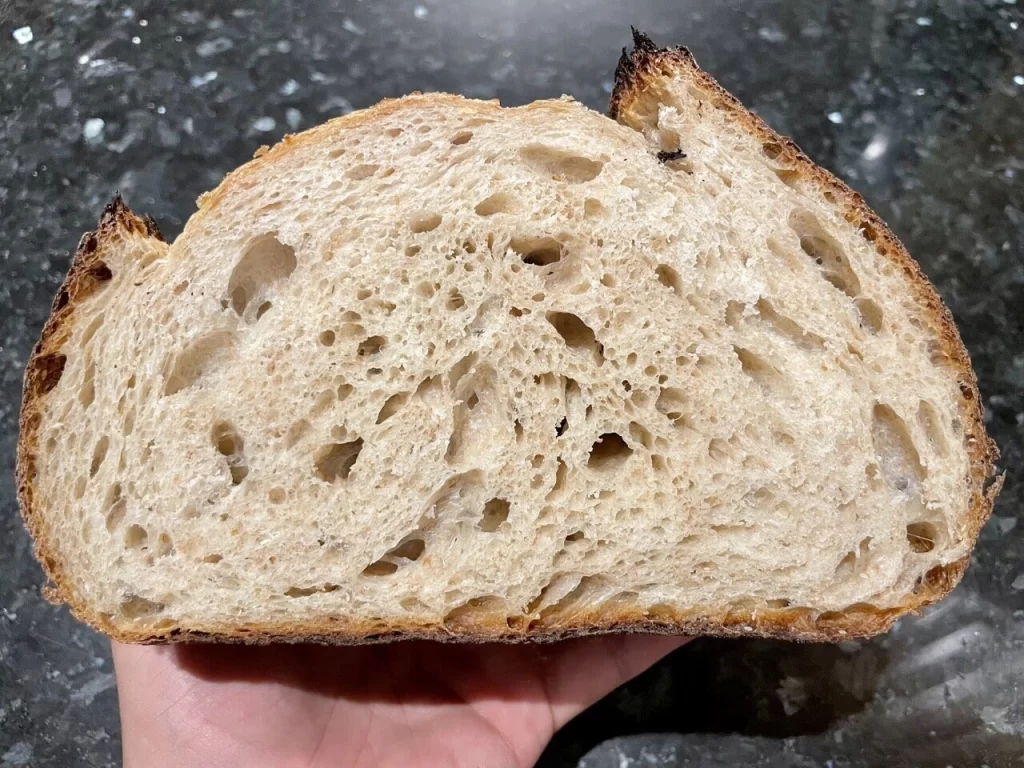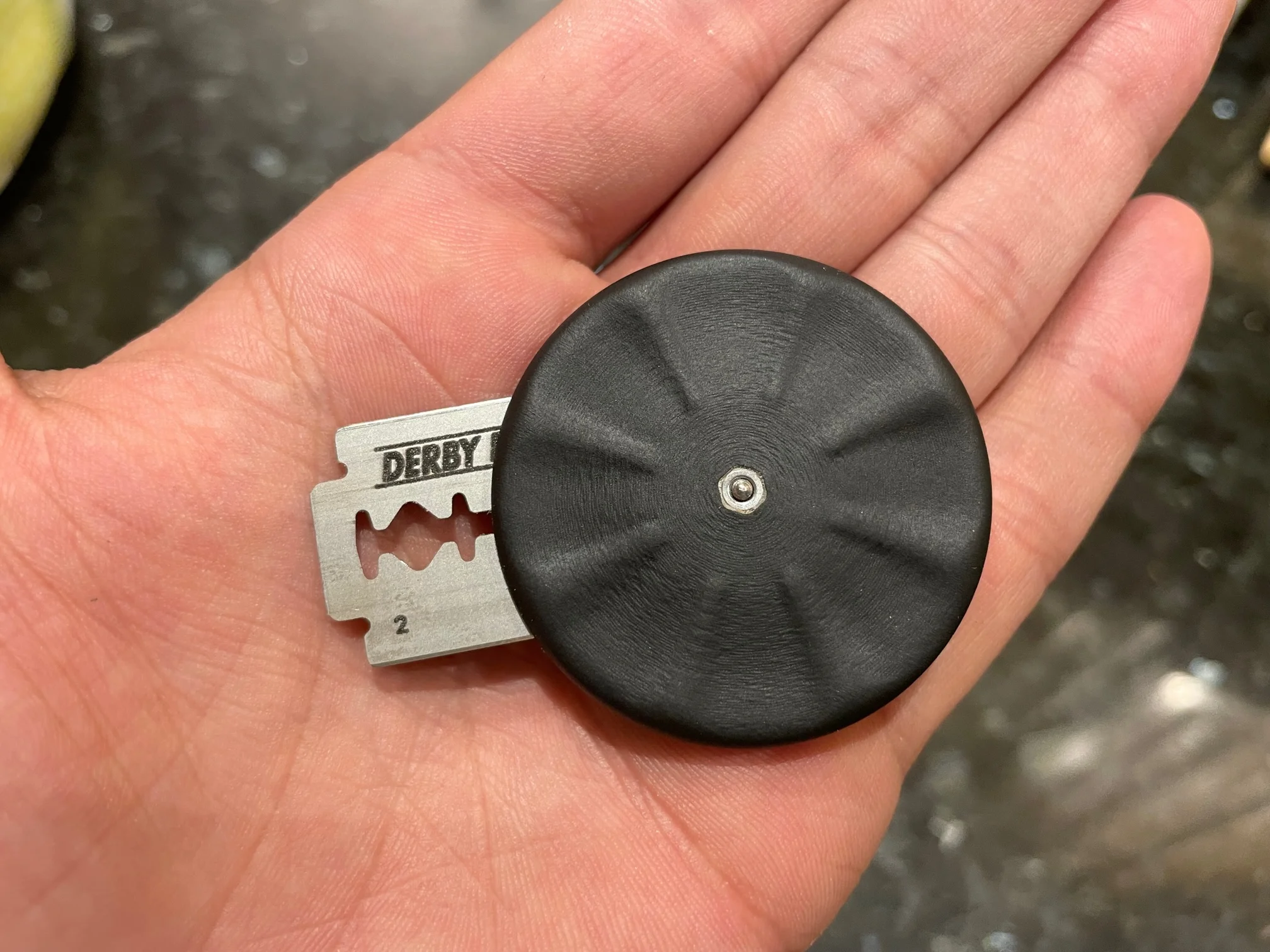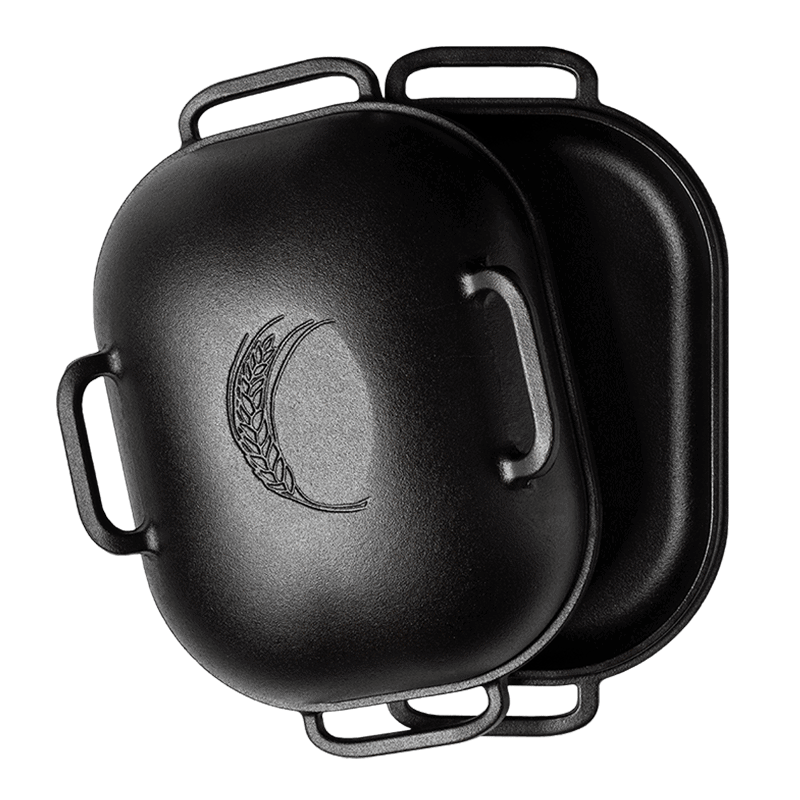12 hours – that’s all the time you need for this same day sourdough bread recipe, from the moment you feed your starter to the second your bread is done baking.

Why This Recipe Works
You can easily make a loaf of same day sourdough bread in just 12 hours from start to finish. The following three steps help us achieve this goal:
- Feeding your sourdough starter early in the morning
- Using warm water in the starter and in the dough
- Doing a first and second rise in a warm spot in the house
Ingredients You’ll Need
- Bread Flour: Use a white bread flour with around 13% protein, like King Arthur brand or Bob’s Red Mill brand.
- Whole Wheat Flour: I usually use King Arthur brand of whole wheat flour, but any brand should be fine.
- Water: Use filtered tap water or bottled spring water.
- Sourdough Starter: A 100% hydration sourdough starter is best for this recipe. You can feed your starter with white flour or any type of whole grain flour.
- Salt: Kosher salt, sea salt, or plain table salt are ideal for this same day sourdough bread.
Note: Check recipe card below for full ingredient amounts and quantities.
Substitutions and Additions
- Use all bread flour instead of adding whole wheat flour: If you just want to use one type of flour, replace the whole wheat flour with an equal weight of white bread flour. The result will be a loaf of white sourdough bread, similar to my master sourdough bread recipe.
Ingredient Amounts
Sourdough Starter Feeding
- Sourdough Starter, leftover from fridge – 25 grams
- Water – 50 grams
- Bread Flour – 50 grams
You can also do the following feeding if you keep more leftover starter on hand:
- Sourdough Starter, leftover from fridge – 100 grams
- Water – 100 grams
- Bread Flour – 100 grams
Main Dough
- Bread Flour – 400 grams
- Whole Wheat Flour – 50 grams
- Water – 300 grams
- Sourdough Starter, active – 100 grams
- Salt – 10 grams
How to Make Same Day Sourdough Bread
Step-by-Step Instructions
Feeding the Starter
- In the early morning, take 25 grams sourdough starter out of the fridge.
- Add 50 grams of warm water to the jar. The water should be warmed to around 80-90ºF (27-32ºC). This will help the starter rise faster.
- Then add 50 grams of bread flour to the jar. Mix everything together thoroughly until no dry bits of flour remain. Mark the top of the starter with a rubber band to see how much it grows, and cover the jar loosely with a lid.
- Place the jar in a warm spot in your house and allow it to rise for 4-5 hours. This should be enough time for it to double in size.
Finding a warm spot for your starter to rise: Usually, I heat up a mug of water in the microwave until it is boiling. Then I turn off the microwave and place my starter jar next to the mug of hot water and I close the microwave door. This creates a make-shift proofing box environment, keeping the starter warm and allowing it to rise faster. I use the same trick for my dough when I want it to rise faster during bulk fermentation.
Mixing the Dough
- Once your starter has doubled in size, mix all of the main dough ingredients together in a mixing bowl: warm water (around 90ºF), starter, salt, whole wheat flour, and bread flour.
- Stir the ingredients together thoroughly until no dry bits of flour remain. Cover up the dough and let it rise for 5-6 hours in a warm place.
Bulk Fermentation (The First Rise)
- During the first two hours that the dough is rising, give the dough three sets of stretch and folds, with a 30 minute rest between each set.
- After letting the dough rest for an initial 30 minutes, grab an edge of the dough and stretch it up into the air, then fold the dough over the top of the dough. Go around the bowl, stretch an edge of dough up in the air and folding it over the top. Keep doing this 6-8 times until the dough gains some structure and starts to give some resistance.
- Cover up the dough and let it rest for 30 minutes. Repeat these steps two more times until you’ve completed three sets of stretch and folds.
- After the third set of stretch and folds, let the dough continue rising in a warm place until the dough has risen a total of 5-6 hours. The dough should be puffy and significantly risen at this point.
Preshaping
- Take the dough out of the bowl or proofing container and set it directly on the kitchen counter, smooth side facing up.
- Preshape the dough into a round ball by cupping and pulling around the edges of the dough with your hands or a bench scraper.
- Let the dough rest on the counter, uncovered, for 30 minutes. This short rest will allow the dough to relax and it will be easier to shape into a loaf shape later.
Final Shape
- After the 30 minute rest, dust an oval-shaped banneton basket with rice flour or regular bread flour.
- Then, brush the top of the dough ball with bread flour and flip it over on the counter so that the smooth side is facing down and the sticky side is facing up.
- Pull out the edges of the dough to form a square shape, then fold the right third of the dough over the middle third, and fold the left third of the dough over the middle third as well.
- Roll the dough over itself to form a tight cylinder. This shape of dough should fit perfectly into a 10-inch oval banneton basket.
Note on shaping: Watch the video tutorial of this recipes to see a detailed shaping demonstration.
- Transfer the dough into the floured banneton basket with the seam side facing up.
Final Proof (The Second Rise)
- Dust the top of the dough with a little bit of bread flour and cover the banneton basket with a kitchen towel.
- Move the dough to a warm place and allow it to rise for 2 hours.
Scoring and Baking
- A half hour before the dough is done proofing, preheat your oven to 500ºF (260ºC) with a Dutch oven inside. Let the oven preheat for 30 minutes.
- Flip the proofed dough out of the basket and onto a sheet of parchment paper or a bread peel.
- Score one long slash in the top of the dough with a razor blade or bread lame.
Get a 10% discount on my favorite Wire Monkey bread lames using my affiliate link here.
- Transfer the dough carefully into the hot Dutch oven and close the lid to trap the steam.
- Bake for 20 minutes with the lid on, then remove the lid and continue baking for another 15 minutes.
- Remove the finished loaf from the oven and place it on a wire rack to cool for at least one hour before slicing.
Same Day Sourdough Bread Recipe

12 hours - that's all the time you need for this same day sourdough bread recipe, from the moment you feed your starter to the second your bread is done baking.
Ingredients
Sourdough Starter Feeding
- Sourdough Starter - 25 grams
- Water - 50 grams
- Bread Flour - 50 grams
Main Dough
- Bread Flour - 400 grams
- Whole Wheat Flour - 50 grams
- Water - 300 grams
- Sourdough Starter, active - 100 grams
- Salt - 10 grams
Instructions
Feeding this Starter
- In the early morning, take 25 grams sourdough starter out of the fridge.
- Add 50 grams of warm water to the jar. The water should be warmed to around 80-90ºF (27-32ºC). This will help the starter rise faster.
- Then, add 50 grams of bread flour to the jar. Mix everything together thoroughly until no dry bits of flour remain. Mark the top of the starter with a rubber band to see how much it grows, and cover the jar loosely with a lid.
- Place the jar in a warm spot in your house and allow it to rise for 4-5 hours. This should be enough time for it to double in size.
Finding a warm spot for your starter to rise: Usually, I heat up a mug of water in the microwave until it is boiling. Then I turn off the microwave and place my starter jar next to the mug of hot water and I close the microwave door. This creates a make-shift proofing box environment, keeping the starter warm and allowing it to rise faster. I use the same trick for my dough when I want it to rise faster during bulk fermentation.
Mixing the Dough
- Once your starter has doubled in size, mix all of the main dough ingredients together in a mixing bowl: warm water (around 90ºF), starter, salt, whole wheat flour, and bread flour.
- Stir the ingredients together thoroughly until no dry bits of flour remain. Cover up the dough and let it rise for 5-6 hours in a warm place.
Bulk Fermentation (The First Rise)
- During the first two hours that the dough is rising, give the dough three sets of stretch and folds, with a 30 minute rest between each set.
- After letting the dough rest for an initial 30 minutes, grab an edge of the dough and stretch it up into the air, then fold the dough over the top of the dough. Go around the bowl, stretch an edge of dough up in the air and folding it over the top. Keep doing this 6-8 times until the dough gains some structure and starts to give some resistance.
- Cover up the dough and let it rest for 30 minutes. Repeat these steps two more times until you’ve completed three sets of stretch and folds.
- After the third set of stretch and folds, let the dough continue rising in a warm place until the dough has risen a total of 5-6 hours. The dough should be puffy and significantly risen at this point.
Preshaping
- Take the dough out of the bowl or proofing container and set it directly on the kitchen counter, smooth side facing up.
- Preshape the dough into a round ball by cupping and pulling around the edges of the dough with your hands or a bench scraper.
- Let the dough rest on the counter, uncovered, for 30 minutes. This short rest will allow the dough to relax and it will be easier to shape into a loaf shape later.
Final Shape
- After the 30 minute rest, dust an oval-shaped banneton basket with rice flour or regular bread flour.
- Then, brush the top of the dough ball with bread flour and flip it over on the counter so that the smooth side is facing down and the sticky side is facing up.
- Pull out the edges of the dough to form a square shape, then fold the right third of the dough over the middle third, and fold the left third of the dough over the middle third as well.
- Roll the dough over itself to form a tight cylinder. This shape of dough should fit perfectly into a 10-inch oval banneton basket.
Note on shaping: Watch the video tutorial of this recipes to see a detailed shaping demonstration.
- Transfer the dough into the floured banneton basket with the seam side facing up.
Final Proof (The Second Rise)
- Dust the top of the dough with a little bit of bread flour and cover the banneton basket with a kitchen towel.
- Move the dough to a warm place and allow it to rise for 2 hours.
Scoring and Baking
- A half hour before the dough is done proofing, preheat your oven to 500ºF (260ºC) with a Dutch oven inside. Let the oven preheat for 30 minutes.
- Flip the proofed dough out of the basket and onto a sheet of parchment paper or a bread peel.
- Score one long slash in the top of the dough with a razor blade or bread lame.
- Transfer the dough carefully into the hot Dutch oven and close the lid to trap the steam.
- Bake for 20 minutes with the lid on, then remove the lid and continue baking for another 15 minutes.
- Remove the finished loaf from the oven and place it on a wire rack to cool for at least one hour before slicing.
Notes
- Finding a warm spot for your starter to rise: Usually, I heat up a mug of water in the microwave until it is boiling. Then I turn off the microwave and place my starter jar next to the mug of hot water and I close the microwave door. This creates a make-shift proofing box environment, keeping the starter warm and allowing it to rise faster. I use the same trick for my dough when I want it to rise faster during bulk fermentation.
- Note on shaping: Watch the video tutorial of this recipes to see a detailed shaping demonstration.
Recommended Products
As an Amazon Associate and member of other affiliate programs, I earn from qualifying purchases.


